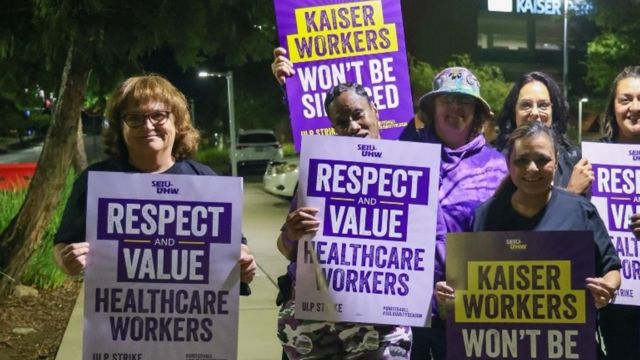Over 75,000 healthcare professionals, including nurses, nursing assistants, technicians, pharmacists, and others, have initiated a strike at Kaiser Permanente in California and beyond. This event is regarded as the largest healthcare strike in recent U.S. history, a rare occurrence in the American medical field where lives are at stake.
While it’s uncommon for medical workers in the United States to strike due to the critical nature of their roles, healthcare strikes are more frequent in other nations. This suggests that Kaiser’s strike may herald a growing trend of labor unrest among healthcare providers in the U.S.
The Kaiser employees are highlighting issues such as inadequate pay and benefits, insufficient training, and subpar working conditions that they believe endanger patients. Health worker unions argue that strikes like this can alleviate persistent staffing shortages, as improved benefits and pay could attract more workers and encourage them to remain in their positions. According to union data from April, 11% of union positions at Kaiser remained unfilled.
A few years ago, my colleagues at Rand Corp. and I conducted a study for the Department of Health and Human Services focusing on entry-level healthcare workers. Our findings revealed numerous challenges faced by this group, including high turnover rates, unfavorable working conditions, low compensation and benefits, and limited opportunities for career advancement or training.
Given the limited influence of these workers within healthcare organizations, striking may be their only means of effecting change. Non-unionized workers may not even have this option.
Medical strikes are more commonplace in other countries. For instance, healthcare professionals in the UK recently participated in a series of strikes, and Israeli doctors went on strike in July due to concerns about their government’s policies. Some American doctors have suggested that physicians in the U.S. should consider adopting organized labor tools to advocate for patients and public health, especially when state interference impacts medical matters like vaccination, masking, and reproductive and gender-affirming care.
In fact, doctors specializing in high-risk pregnancies have relocated from states with restrictive abortion policies to places where they can better serve their patients. During the COVID-19 pandemic, it became evident that expertise in fields like science and medicine faced challenges and lost trust and respect, further burdening healthcare professionals. Scientists and doctors found themselves marginalized, with their opinions often receiving less respect than those of social media influencers.
While there was widespread applause for front-line healthcare workers during the pandemic, they often faced shortages of protective equipment and were at a significantly higher risk of infection in the early stages of the virus’s spread. This led to a considerable number of healthcare worker deaths worldwide, including over 3,600 in the United States, within the first year and a half of the pandemic.
Demanding better working conditions for themselves along with improved patient care is a relatively recent development among the U.S. medical workforce. Kaiser’s nurses, technicians, and pharmacists may currently be outliers, but they could be setting an example for the broader American healthcare sector to advocate for their needs and values.

